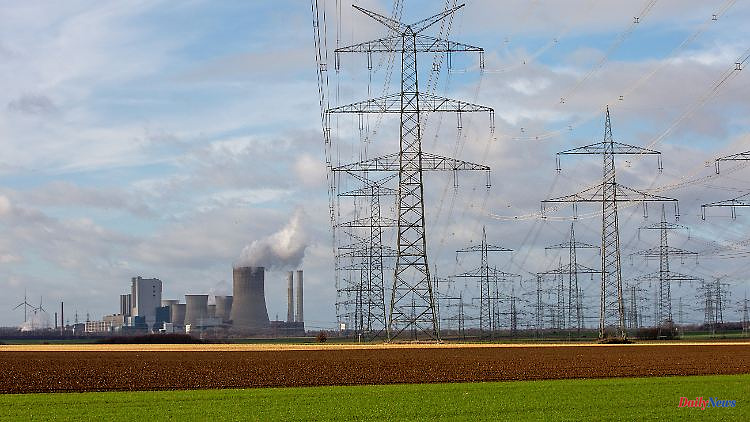According to a new study, the expansion of renewable energies is progressing - but still much too slowly for the climate goals that the traffic light government has set itself. The CO₂ emissions do not go down either. The reason is the short-term restart of coal-fired power generation during the energy crisis.
As expected, the increased use of coal-fired power plants as a substitute for gas has thwarted the German climate targets for 2022. According to an evaluation by the Agora Energiewende think tank, the use of coal and oil nullified the greenhouse gas savings, although overall energy consumption fell by almost five percent, mainly because of the high prices. "In 2022, the climate goals fell behind due to short-term measures for energy security," criticized Agora boss Simon Müller. The transport and building sector was again unable to meet its targets last year. According to provisional figures, Germany produced 761 million tons of greenhouse gas, almost exactly as much as in 2021. The self-imposed upper limit for 2022 was missed by around five million tons.
CO₂ emissions stagnated at a high level despite reduced energy consumption, comparatively warm weather and favorable conditions for wind and solar systems. "This is an alarm signal with regard to the climate goals," said Müller. He also pointed out that the traffic light coalition has so far failed to deliver its announced immediate climate protection program. The government must turn the tide by 2023. With a minus of 39 percent compared to 1990, emissions are still below the 40 percent target for 2020 at the time. By 2030, Germany wants to reduce emissions by 65 percent.
Traffic remains the major problem area among the sectors: According to Agora, CO₂ emissions there were 150 million tons, well above the 139 million tons permitted under the Climate Protection Act. The reasons for missing the target are the traffic volume, which increased again after the corona decline, and the lack of political instruments to reduce emissions. The industrial sector, on the other hand, has met its targets. This is a result of energy savings and more efficiency. Nevertheless, more is needed to achieve the targets for 2030.
According to the Agora evaluation, renewable energies produced more electricity than ever before in 2022, at 248 terawatt hours - an increase of around ten percent compared to 2021. Wind power remained the largest supplier of electricity among the renewables. At the same time, production from solar power plants increased by 23 percent compared to 2021 - thanks to an above-average sunny year and a strong expansion of new plants.
In order to achieve the goals it has set itself, Germany must nevertheless significantly accelerate the expansion of renewable energies. "The expansion of renewable energies is the foundation for everything else," said Müller. The pace must increase in order to reduce greenhouse gas emissions there, but also to cover the increasing demand for electricity, for example for industrial processes. Through a greater use of electricity, climate-damaging energy sources are to be pushed back - be it in electric cars, heat pumps for heating or in industry.
The status of the expansion in figures: Overall, renewable energies were expanded much faster last year than in 2021, by 9.6 gigawatts, 61 percent more than in the previous year. The total installed capacity of renewables at the end of 2022 was 148.2 gigawatts. But according to Agora Energiewende, that is far from enough: According to calculations by Agora Energiewende, the rate of expansion for solar systems would have to more than double, for onshore wind turbines it would have to more than triple and for wind farms at sea even more than eightfold.
However, the balance sheet varies greatly depending on the area. The largest increase in renewable energies last year was in solar systems. According to preliminary data, systems with a capacity of 7.2 gigawatts were newly commissioned, an increase of 44 percent compared to the previous year. In order to achieve the capacity target of 215 gigawatts by 2030 laid down in the Renewable Energy Sources Act, an average increase of 18.6 gigawatts per year would be necessary from 2023, Agora calculates.
A capacity of 2 gigawatts was added to onshore wind turbines last year, around 21 percent more than in the previous year. That was the third increase in a row, albeit from a low level. In order to achieve the 2030 target of 115 gigawatts, plants with a capacity of around 7.1 gigawatts would have to be built per year. Wind energy at sea has been slow, with only 0.3 gigawatts of new capacity in 2022 according to preliminary data. According to the Wind Energy at Sea Act, there should be at least 30 gigawatts by 2030, which would correspond to an annual increase of 2.7 gigawatts on average .
The federal government has passed extensive changes in the law for faster expansion. Two percent of the entire federal area on land should be designated for wind turbines. The federal states should provide more space in the coming years. Federal Economics and Climate Protection Minister Robert Habeck said recently that the development points "in the right direction". In addition to more areas for wind power, Agora also considers the designation of so-called go-to areas to be necessary - areas that are generally considered suitable for wind turbines and where this does not therefore have to be determined individually for each new project. Construction on the outskirts of cities must also become easier.












